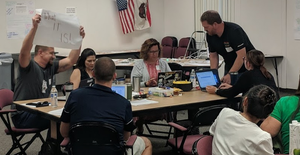
As an educator, my favorite brain network to activate was the strategic networks, allowing students multiple means of action and expression.

I loved going “beyond choice boards” to encourage students themselves to ideate as to the best way to demonstrate their understanding of academic content. Once I left the classroom and began conducting professional development sessions, I sought out ways to activate the strategic networks with adult learners. After all, the concept of multiple means of action and expression is a guideline of Universal Design for Learning (UDL), which is grounded in neuroscience. If we are using brain research to guide the way we design learning experiences for students, it is only logical that we consider the same with learning sessions for educators.
In a professional development workshop for educators this fall, I provided learners with multiple options for action and expression. In small groups, educators were instructed to demonstrate their recent learnings regarding computer science practices using any method of their choice.

Each group was given time to prepare and then presented this information to the entire cohort of educators in attendance at the workshop. A couple of groups went with a traditional method of using Google Slides or Powerpoint to present their learnings. This proved to be an effective and familiar method of presenting information. A few groups created a poster on chart paper.

This was also an effective presentation method, as it allowed educators to view pertinent information while the group spoke of their learnings. While there were a number of groups that chose this method, I noted that there was variability as to the way each of the posters had been designed. One group categorized and color-coded text on their poster to provide clarity to their message.

Yet another group created a poster that contained visual sketches to represent the content being presented. The only text on the poster was in the form of an overall title. It is the lack of specificity regarding the task, the open-ended nature of the assignment, that resulted in this variability. We honor our learners, whether students or adults, when we allow for multiple options for demonstrating understanding. In the classroom, the practice of providing autonomy regarding action and expression is based on neuroscience, and I have seen it reveal learner strengths that might otherwise have gone unrecognized. There are those that argue that providing open-ended choice leads to chaos, that students and adults need clear expectations and guidelines. The strategy of providing multiple methods of action and expression is not a free for all. We are tough on content, but easy on delivery.
The expectations for each learner regarding grade level standards or learning objectives for a professional development session are not changed when we introduce this method. Rather, we allow for creativity of the way that learners express their understanding of the content. This method celebrates variability of presenting learning.

It also meets another UDL guideline, provide multiple methods of representation, as learners presenting information to each other is done a myriad of ways. A third group that opted to present their learnings using a poster created a visual flow chart. The variety of methods supports the educators in the room who are learning from their colleagues. Each of us prefers to learn in different ways. A one sizes fits all approach is not effective. The goal of UDL is to create expert learners. This applies to adult learners just as much as it does with our students in classrooms.
While I expected to see learning presented during the session via digital presentation platforms and posters, it was a joy to witness the creativity of groups who employed methods I had never considered.

One group prepared a role play to conduct for the cohort of participants. The group decided to demonstrate the way they would teach their learners to the educators they would encounter at their school site, those colleagues who were not in the workshop. Mixed into this presentation was humor, modeling of a real life situation, and relevance to participants. Another innovative method of action and expression I had the pleasure to witness was the creation of a fake Twitter account.

This group created a mock account for the computer science practice they were representing to their peers. As the importance of social media and connected learning was a foundation of the work of this cohort, this provided a meaningful bridge to previous learnings as well.
As facilitators of professional development, we must empower our adult learners. Tap into their creativity, their interests, their uniqueness. As we provide for multiple options of action and expression we do more than merely activate the strategic network of the brain. We also validate our people. We honor those we serve. And we model methods that these educators can bring back to the classroom to implement with their own students.
